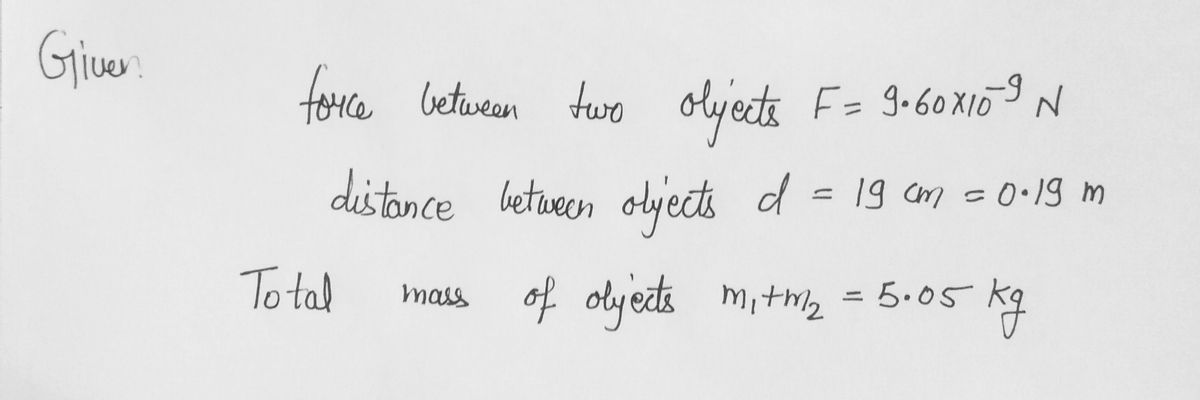Two objects attract each other with a gravitational force of magnitude 9.60 x 109 N when separated by 19.0 cm. If the total mass of the objects is 5.05 kg, what is the of each? heavier mass kg
Gravitational force
In nature, every object is attracted by every other object. This phenomenon is called gravity. The force associated with gravity is called gravitational force. The gravitational force is the weakest force that exists in nature. The gravitational force is always attractive.
Acceleration Due to Gravity
In fundamental physics, gravity or gravitational force is the universal attractive force acting between all the matters that exist or exhibit. It is the weakest known force. Therefore no internal changes in an object occurs due to this force. On the other hand, it has control over the trajectories of bodies in the solar system and in the universe due to its vast scope and universal action. The free fall of objects on Earth and the motions of celestial bodies, according to Newton, are both determined by the same force. It was Newton who put forward that the moon is held by a strong attractive force exerted by the Earth which makes it revolve in a straight line. He was sure that this force is similar to the downward force which Earth exerts on all the objects on it.
![### Problem Statement
Two objects attract each other with a gravitational force of magnitude \(9.60 \times 10^{-9}\) N when separated by \(19.0\) cm. If the total mass of the objects is \(5.05\) kg, what is the mass of each?
- **Heavier mass:** \(\_\_\_\_) \text{ kg}\)
- **Lighter mass:** \(\_\_\_\_) \text{ kg}\)
### Explanation
This problem involves calculating the individual masses of two objects based on the gravitational force between them and the total combined mass. The problem provides the gravitational force, the separation distance, and the total mass. It requires applying the formula for gravitational force and solving for the individual masses.
### Key Concepts
- **Gravitational Force Formula:**
\[
F = \frac{G \cdot m_1 \cdot m_2}{r^2}
\]
where \(F\) is the gravitational force, \(G\) is the gravitational constant \((6.674 \times 10^{-11} \, \text{N(m/kg)}^2)\), \(m_1\) and \(m_2\) are the masses of the objects, and \(r\) is the distance between the centers of the two masses.
- **Total Mass Equation:**
\[
m_1 + m_2 = 5.05 \text{ kg}
\]
### Steps to Solve
1. Convert the separation distance from centimeters to meters.
2. Use the gravitational force formula to set up an equation.
3. Use the total mass to set up a system of equations.
4. Solve the system of equations to find the individual masses.](/v2/_next/image?url=https%3A%2F%2Fcontent.bartleby.com%2Fqna-images%2Fquestion%2F84f39a0e-1c16-43ec-bcb3-7f889ca233a2%2Fb9c42c78-6889-411b-b53c-586d0c0d09fd%2Fv5qq9ko_processed.png&w=3840&q=75)

Step by step
Solved in 2 steps with 2 images









